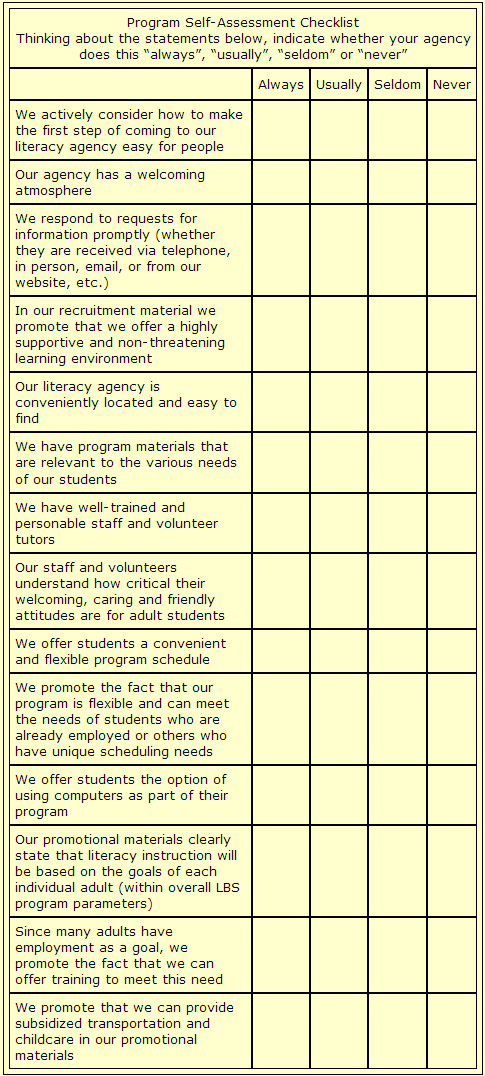 Breaking Down the Barriers
Breaking Down the Barriers
Some barriers that adults face to participation in literacy programs are beyond our control, but many others are not. In this section, we will review some of the program design issues and talk about how we might better address the needs and barriers of potential learners in order to encourage more people to join our programs.
Suggestions from ABC Life Literacy:
Based on past research and studies, ABC Life Literacy made recommendations to Canada’s literacy programs on how to reduce some of the barriers to learner recruitment:
- Use images and concepts that dispel the myth that adult learning is similar to early schooling. Show that the classroom might be as simple as a group of people sitting around a table or a student/tutor pair working together.
- Explain exactly what small groups, tutoring and classes are like, who the learners and teachers are, and what kinds of materials are used.
- Highlight the variety of programming options available at your literacy agency.
- Make it clear that most programs do not mix adults with children or teenagers.
- Clearly explain that literacy instructors and tutors have a great deal of sensitivity in dealing with adults who have been away from the classroom for a long time.
- Reinforce that upgrading is for adults of all ages.
- Clearly show that your program is learner-centered and that adults have much more control over their learning environment than they did as children.
- Demonstrate that adults do not have to pick up their schooling where they left off. Highlight that programs are learner-centered and learners decide what it is they want to achieve.
- Highlight that programs are of differing lengths and that people can work at their own pace. This doesn’t mean that programs run indefinitely, but rather that learners will set-up a learning timeline best suited to their needs and to program requirements.
- Present upgrading as an important step in providing opportunities to achieve their dreams!
Program improvements suggested by adult students:
- More hours per week with an instructor or tutor
- Smaller classes
- More individual attention
- More relevant material
- Teachers and tutors who are more knowledgeable
- Diverse program locations
Program-Related Questions
Given the many factors that affect a potential learner’s decision to attend a literacy program, we have ample information to draw from in order to improve our approaches to recruitment.
Use the following list of statements as a means of assessing your program’s current strengths and weaknesses related to successful recruitment. Talk over these questions with agency stakeholders such as students, volunteers, board members and community partners. But remember, if you are asking these questions; be prepared to act on key findings within what is reasonable and manageable for your literacy agency. And if you find that your agency is already acting on most of these suggestions, you might need to ask if you are promoting your strengths forcefully enough.

After thinking about the above statements on effective recruitment practices, you may decide that now would be a good time for your agency to take a closer look at what you do and how you go about it. Perhaps it is even time for some changes.
An Example of Program Design in Action
The following common barriers and program design issues faced by adult students were shared with us from a community-based literacy agency. They included this information in a program newsletter to share with potential learners, their families and friends, and the broader community:
Often, adult learners
- Feel embarrassed about returning to school
- Feel embarrassed to join classes with younger students
- Hold negative impressions of their own abilities
- Hold negative impressions of schools and teachers
- Have problems with childcare and transportation
- Lack time
- Lack confidence
- Lack information about opportunities to learn
So here at our centre, we are dedicated to:
- Establishing a friendly, open atmosphere where the participants can learn
- Making learning a stress-free experience
- Teaching things that are important to the participant
- Helping with transportation
- Making sure that learning is fun and free
- Teaching things that are important to every day life, such as computers, healthy living, job readiness, budgeting and problem solving
Questions and Activities for Reflection
- List the features of your program that effectively meet the needs and address the barriers faced by adult learners.
- Based on the information in this section, how might you adapt or change your program to attract new learners?
- What could you do differently to make the first step of coming to your program even easier for adult students?
- How could you get feedback from current or former students about your agency’s approach to recruitment?
- What additional steps could your agency take to provide a welcoming, non-threatening environment for adult learners?




